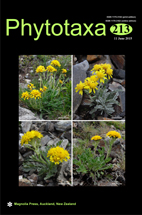Abstract
Centrolepis milleri, a new species endemic to southwestern Western Australia is described and illustrated. The species is restricted to sandplains and currently known from several sites in the Eneabba sandplain on the southern end of the Geraldton Sandplains Bioregion and a single site on the Esperance Sandplain NE of Albany. Although apparently not collected until 2003, C. milleri is common at several locations. Specimens of C. milleri grow with their leaves mostly buried by sand. This semi-subterranean habit is possibly an adaptation to avoid light stress. Centrolepis milleri superficially resembles C. drummondiana, but differs from it in the presence of two to five cataphylls at the base of a scape, in the absence of a spikelet in the axil of the lower primary bract, in the dimorphic morphology of the primary bracts and in the presence of one long and one short tepal-like phyllome associated with each flower. The absence of a spikelet in the axil of the lower primary bract and the dimorphic nature of the primary bracts are shared with species such as C. polygyna and C. glabra, to which C. milleri is apparently related. The combination of inflorescence characteristics found in C. milleri is unique in Centrolepis, and its inclusion in phylogenetic reconstructions of inflorescence evolution in this unusual genus is therefore significant.

